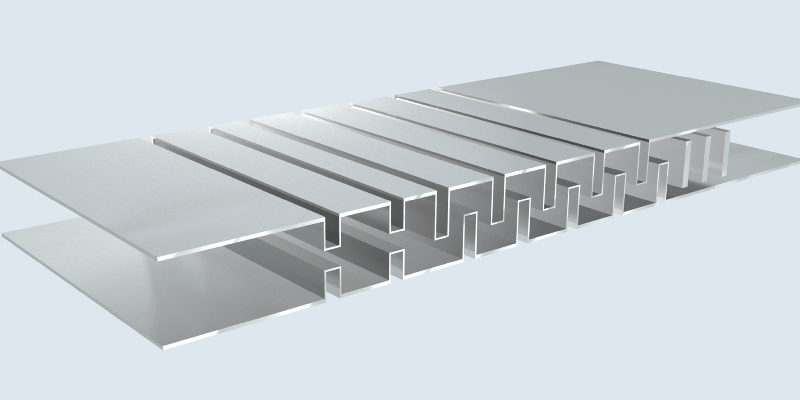Acoustic Diode Hits the Perfect Note
Researchers have created a device that—with high efficiency and no energy input—transports a sound wave of a specific frequency and shape while not allowing the wave to be transmitted in the reverse direction. This unidirectional device circumvents the side effects that have plagued other devices, such as the distortion of transmitted signals. The device is a modified waveguide that includes three regions with different resonant properties. The structure could lead to improvements in ultrasound imaging and other acoustic technologies.
One-way components are essential in electronic circuits and in optics, but there is no acoustic equivalent that works as well as the digital and optical versions. One-way acoustic devices could be helpful in sharpening ultrasound images and could lead to novel ways of controlling acoustic noise and of computing with acoustic waves, rather than digital signals, according to experts. Previous versions used photonic crystals and special materials to force one-way signal transmission, but these approaches dramatically reduced the strength of the transmitted wave and shifted its frequency. More complex systems can achieve better performance, but they need a power source, which can be unwieldy.
Jie Zhu, now at Hong Kong Polytechnic University, and Xuefeng Zhu, now at Huazhong University of Science and Technology, China, developed their device in collaboration with others when the two were at the University of California, Berkeley. The structure is a waveguide made of a pair of parallel sheets of aluminum. The sheets have trenches bent into them, so that a wave propagating between the plates encounters rectangular “bumps” protruding from above and below. The waveguide comprises three sections. The first has the bumps from above and below lined up, the second has their positions staggered, and the third has a series of thin vertical bars suspended in the middle of the waveguide.
The three sections act as resonant chambers in which the incoming sound creates standing waves. As in any resonant cavity, the standing wave patterns, or modes, can be either even or odd. Even modes have mirror symmetry, like a standing wave on a string that has a single lobe moving up and down, whereas odd modes are antisymmetric, like a two-lobed standing wave, where one lobe is up whenever the other is down. In a uniform waveguide, the traveling wave mode called the fundamental has uniform pressure across the waveguide cross-section at each location, and it’s considered even. The first odd waveguide mode has a horizontal, zero-pressure nodal plane along the waveguide axis, and at a given horizontal position, the pressure closer to the top plate is high whenever the pressure near the bottom plate is low.
In the waveguide, the first section allows only even modes to resonate and thus transmit through to the second section, effectively blocking odd modes. The second section allows a combination of even and odd modes and acts as an even-to-odd converter, while the third section allows only odd standing modes, which are then converted to odd traveling waves. The team chose the dimensions of the waveguide and the bumps to be optimized for a 2290-Hz sound wave in the fundamental mode to transmit through the whole structure in the forward direction only. However, an odd-mode wave of the same frequency could in principle propagate through in the opposite direction, emerging as an even mode. The one-way property only applies to a specific mode, although it takes special efforts to produce modes other than the fundamental.
The researchers found that the maximum energy transmission (93%) occurred at 2280 Hz, close to the predicted value of 2290 Hz. 93% efficiency was far above the 30% or less reported for previous one-way acoustic devices (although many of the teams building them did not report an efficiency value). Transmission in the reverse direction was nearly zero.
Jie Zhu acknowledges that the device works only in a narrow frequency range; in future work, the team plans to broaden the structure’s operating bandwidth. Zhu and his colleagues also plan to use their device for acoustic circuits that can carry out logic functions for computation.
“The interesting thing about this work is that the authors design their material like building blocks,” says Bin Liang, an acoustics specialist at Nanjing University in China. “Unlike previous work from other groups, it requires [no] external power support.” This work, he says, represents “a new type of acoustic diode.” Steve Cummer, an engineer at Duke University in North Carolina, says the device shows that “a relatively simple structure, but still carefully and thoughtfully designed, can actually be a fairly effective one-way window for sound.”
This research is published in Physical Review Applied.
–Sarah Wild
Sarah Wild is a freelance science journalist based in Johannesburg, South Africa.





